|
4. Großräumige Struktur und Kosmologie
|
4. Large-Scale Structure and Cosmology
|
|
Lange Zeit war die Kosmologie ein Forschungsgebiet
theoretischer Modellierung und Spekulation. Erst in jüngster Zeit wurde es
durch die instrumentelle Entwicklung in allen Wellenlängenbereichen
ermöglicht, zwei wichtige Aspekte der Kosmologie durch Beobachtungen zu
untersuchen: die großräumige Struktur unseres Universums und ihre Entwicklung
vom ersten Auftauchen astronomischer Objekte bis heute. Gegenwärtig ist die
beobachtende kosmologische Forschung eines der blühendsten Gebiete der
Astrophysik. Am MPE gibt es dazu Beiträge aus allen Wellenlängenbereichen:
zur Struktur von Galaxienhaufen und ihrer Beziehung zur Entstehung kosmischer
Strukturen, zur Vermessung der großräumigen Struktur und zum Test
kosmologischer Modelle mit Hilfe von Galaxienhaufendurchmusterungen, zum Studium
der Galaxienentwicklung und der Eigenschaften sehr entfernter Galaxien und
zum Ursprung des Röntgen- und Gammastrahlungshintergrundes. Das wichtigste
Ziel ist die Identifizierung des kosmologischen Modells, das den
Beobachtungen am besten entspricht und die Beschreibung der
Strukturentstehung, der Sternbildung und der Elementsynthese im Universum.
|
In the past cosmology was mostly the realm
of theoretical modelling and speculation. Only recently have observational
instruments in all wavelength regions become powerful enough that we can
study two important aspects of cosmology in detail: the large-scale structure
of the Universe and its evolution from the emergence of the first visible
objects to the present. Currently this is one of the most flourishing fields
in astrophysics. Observational cosmological research at MPE covers several
important topics concerning all wavelength ranges from radio to gamma rays:
the structure of galaxy clusters and its relation to cosmic structure
formation, the measurement of the large-scale structure and the test of cosmological
models based on cluster surveys, the study of the evolution of the galaxy
population and the astrophysics of very distant galaxies, and the origin of
the X-ray and gamma ray background. The final goal is the identification of
the most consistent cosmological model, an understanding of the history how
structure emerged in our Universe, and when and how most of the stars and
heavy elements were
formed.
|
|
4.1 Astrophysik von Galaxienhaufen
|
4.1 Galaxy Cluster Astrophysics
|
|
Galaxienhaufen sind die größten, klar definierten Bausteine
des Universums. Sie sind deshalb wichtige Laboratorien für das Studium einer
Vielzahl interessanter physikalischer Phänomene auf sehr großen Skalen, z.B.
zur Untersuchung einer großen Zahl gleich entfernter Galaxien oder der Natur
des heißen intergalaktischen Haufenplasmas. Aus der Beobachtung dieses Plasmas
erhalten wir so bedeutende Informationen wie über das Dichteverhältnis von
herkömmlicher baryonischer und unbekannter Dunkler Materie im Universum und
über das Integral der Produktion schwerer Elemente aus der gesamten
Sternbildungsrate.
|
Clusters of galaxies are the largest, clearly
defined building blocks of the Universe. They are ideal laboratories for
studying many interesting astrophysical phenomena on very large scales, for
example the population of a large number of coeval galaxies and the nature of
the intergalactic medium trapped in the gravitational potential of the
clusters. From the latter we obtain for example the important information on
the ratio of conventional (baryonic) to so far unknown dark matter in the
Universe and on the integrated history of heavy element production by star
formation.
|
|
Eines der wichtigsten Ereignisse für diese Forschungsrichtung
war im vergangenen Jahr die Inbetriebnahme des ESA Satellitenobservatoriums
XMM-Newton, das Beobachtungen von Galaxienhaufen mit bisher nicht gekannter
spektraler Auflösung and Empfindlichkeit ermöglicht. Erste Ergebnisse aus der
Kalibrationsphase, z.B. die Beobachtungen der eliptischen Riesengalaxie M87
im Virgo-Haufen, illustrieren die vielversprechenden neuen Möglichkeiten.
Auch das etwa ein halbes Jahr früher gestartete CHANDRA Observatorium der
NASA liefert spektakuläre neue Ergebnisse über Galaxienhaufen.
|
One of the most exciting events in this
field in the past year has been the start of the operation phase of ESA's
XMM-Newton observatory, which offers unprecedented sensitivity and spectral
resolution for X-ray observations of galaxy clusters. First results from the
calibration phase observations of the giant elliptical galaxy M87 in the
centre of the Virgo cluster highlight these exciting new observational
avenues. Also the CHANDRA observatory, launched only half a year earlier by
NASA, is now showing an increasing number of interesting and surprising
results on galaxy clusters.
|
|
Beobachtungen mit XMM-Newton
|
XMM-Newton observations
|
|
Die XMM Beobachtung von M87 überdeckt eine Region mit einem
Radius von 70 kpc (220 000 Lichtjahre) im Virgo-Galaxienhaufen. Die Stärke
von XMM wird in dieser Beobachtung z.B. dadurch illustriert, dass für den
aktiven Kern und den nur 12 - 13 Bogensekunden davon entfernten hellen Knoten
im Jet separate Spektren gewonnen werden können. Zum ersten Mal konnte für
beide Quellen nicht-thermische Emission (vermutlich Synchrotronstrahlung) im
Röntgenbereich nachgewiesen werden. Beim Jet weißt das Spektrum auf in-situ Beschleunigung
der relativistischen Elektronen hin. Die thermische Emission aus dem heißen
Gashalo füllt den ganzen Detektor aus und hat ein ausgeprägtes Maximum im
Zentrum von M87, wie auf dem Titelbild des Jahresberichtes gezeigt. Die große
Zahl von registrierten Photonen (mehr als 12 Millionen) erlaubt detaillierte
spektroskopische Untersuchungen und Messungen der Elementhäufigkeiten für die
9 wichtigsten schweren Elemente in verschiedenen Regionen des Röntgenhalos.
Abb. II-49 zeigt die mit den Instrumenten EPIC-pn und EPIC-MOS
unabhängig voneinander bestimmten Temperaturen und Häufigkeiten als Funktion
des Radius. Es gibt einen deutlichen, zentralen Temperaturabfall, der auf
erhöhte Kühlung im Zentrum zurückzuführen ist. Für jede radiale Region kann
das Spektrum jedoch durch Plasma bei einer festen Temperatur beschrieben
werden. Dies macht die Beobachtungen inkonsistent mit den Standardmodellen
für inhomogene "cooling flows", die üblicherweise verwendet werden, um die
starke Kühlung im Zentrum mancher Galaxienhaufen zu erklären, denn dieses
Modell sagt für jedes zentrale Gebiet mehrere Gasphasen in einem weiten
Temperaturbereich voraus. Das Spektrum des hochauflösenden Reflection
Gratting Spectrometer (RGS) zeigt ebenfalls eine Überraschung: von cooling
flow Modellen vorrausgesagte Linien werden nicht beobachtet.
|
The XMM X-ray observation of M87 covers a
radius of 70 kpc (220 000 light years) in the halo of the galaxy and the
centre of the Virgo cluster. XMM gives proof of its capabilities by the
spectral and spatial resolution of the emission of the nucleus and the brightest
part of the jet in M87, which are separated by only 12 - 13 arcsec. It could
be shown for the first time that the emission from both regions is purely
non-thermal, most probably synchrotron emission. In particular the overall
spectrum of the emission from the jet is suggestive of reacceleration of
relativistic particles at the site of strongest X-ray emission. The emission
of the hot intracluster gas covers the whole field of view with a steep peak
at the centre of M87. An X-ray image obtained with the pn-detector and a spectrum
of the thermal emission from the central 2 arcmin region is shown as the
cover picture of this report. The good photon statistics of the observation
allows the study of detailed features of the spectrum and a detailed analysis
of the abundances of the nine astrophysically most important elements.
Fig. II-49 shows the radial temperature distribution determined
independently and consistently with the two instruments EPIC-MOS and EPIC-pn.
There is a prominent temperature decrease towards the centre, an effect of
the increased cooling in the dense central regions. Models involving a single
gas temperature can explain the spectra of most of the radial range of the
X-ray halo. Therefore this observation is inconsistent with the standard
inhomogeneous "cooling flow" model used to describe the effect of strong radiative
cooling in cluster centres, because this model predicts a pronounced
multi-temperature structure. The spectrum from the high resolution Reflection
Grating Spectrometer (RGS) obtained for the innermost region provides some
independent spectral constraints - from lines predicted but not observed - in
conflict with the cooling flow model.
|
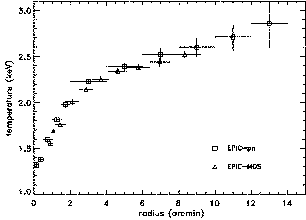
|
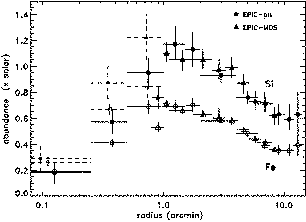
|
|
Abb. II-49: Radiale Profile der Temperatur
(links) und der Silizium- und Eisenhäufigkeit(rechts) im röntgenemittierenden
Plasmahalo von M87. Es zeigt sich eine sehr gute Übereinstimmung der
Ergebnisse aus den Messungen mit den EPIC-pn und EPIC-MOS Detektoren.
Fig. II-49: Radial temperature
(left), Fe and Si abundance (right) distribution in the X-ray emitting gas in
the halo of M87 as determined from observations with the XMM detectors
EPIC-pn and EPIC-MOS. Note the good agreement between both instruments.
|
|
Abb. II-49 zeigt auch die radiale Variation der
Häufigkeiten von Eisen und Silizium. Neben einer Häufigkeitsabnahme nach
außen beobachtet man einen starken Abfall zum Zentrum. Letzteres kann auf
resonante Linienstreuung zurückgeführt werden, einen Effekte den man hier zum
ersten Mal deutlich in einem Galaxienhaufen beobachtet. Erste
Strahlungstransferrechnungen zeigen, dass diese Interpretationen vermutlich
richtig ist.
|
Fig. II-49 also shows the
radial abundance distribution of the most prominent heavy elements silicon
and iron. Both elements show a decrease in abundance with radius and an
apparent drop at small radii. The latter effect can be attributed to
absorption by resonant line scattering, an effect seen here clearly for the
first time. First results of radiation transfer models (under development)
show that this effect can give a consistent explanation of the apparent
central decrease.
|
|
In der Kalibrationsphase wurden zwei weitere, sehr massive
Galaxienhaufen beobachtet, Abell 1795 und Abell 1835, die beide einen
starken "cooling flow" beherbergen sollen. Die Spektren die mit den EPIC-pn
und EPIC-MOS Detektoren für Abell 1835 gewonnen wurden und auf eine
globale Temperatur von etwa 8.2 keV hinweisen, werden in Abb. II-50
gezeigt. Das RGS-Spektrum zeigt aber auch kühlere Phasen bis zu einer
Minimaltemperatur von ca. 3 keV, während Linien, die unterhalb einer
Temperatur
von 2.5 keV auftreten sollen, nicht beobachtet werden. Solche kühleren Phasen
werden jedoch von cooling flow Modellen prognostiziert. Dies ist eines der
überraschendsten Ergebnisse. Im Licht dieser Beobachtungen und der Ergebnisse
für M87 müssen wir die Modelle zur Kühlung in den zentralen Haufenregionen
neu überdenken.
|
The XMM calibration phase observations
also comprise two further, massive and distant clusters, A1795 and A1835,
which are known to harbour strong "cooling flows" in their centres. For the
cluster A1835, for which spectra obtained with the EPIC-pn and Epic-MOS
detectors
are shown in Fig. II-50, a global temperature of 8.2 keV is
determined. The spectral lines seen with the RGS instrument emitted from the
central region of the cluster indicate the presence of a cooler phase at
around 3 keV, but further lines that probe still cooler gas below 2.5 keV are
missing from the spectrum. These are expected in the steady state cooling
scenario of the cooling flow model. This is the most surprising result of
these observations. In light of these results and those of the M87
observations we must reconsider the models for the structure of the strongly
cooling central regions in clusters.
|
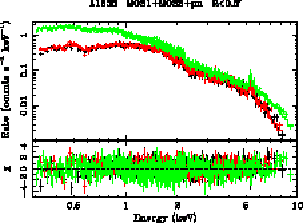
|
Abb. II-50: Röntgenspektrum von Abell 1835
gemessen mit EPIC-pn und EPIC-MOS. Das Spektrum zeigt eine starke Eisenlinien
bei 6.7 keV. Die globale Form des Spektrums weist auf eine Temperatur von
etwa 8.2 keV hin.
Fig. II-50:
X-ray spectrum of the galaxy cluster A1835 obtained with the EPIC-pn and
EPIC-MOS detectors on board XMM Newton. The spectrum shows a strong iron line
at 6.7 keV, which also provides a redshift of the cluster well consistent
with the optical result. The overall spectral shape indicates a global
temperature of the intracluster medium of 8 keV.
|
|
CHANDRA Beobachtungen
|
CHANDRA observations
|
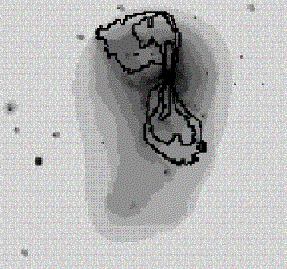
|
Abb. II-51: Chandra Röntgenbild (Graustufen) und
Radioaufnahme (Konturbild) der Virgo-Haufen-Galaxie M84. Deutlich sind
Gebiete geringer Flächenhelligkeit im Röntgenbild an der Stelle der
Radiokeulen zu sehen, was darauf hindeutet, dass das relativistische Radioplasma
das röntgenleuchtende Plasma verdrängt.
Fig 51: Chandra image of the Virgo
galaxy M84 (grey scale) and radio image (contours). Clearly seen are the low
surface brightness regions in X-rays at the location of the radio lobes,
which is an indication that the relativistic radio plasma is pushing the
X-ray emitting gas out off the lobe regions.
|
|
Das CHANDRA-Observatorium bietet vor allem eine sehr hohe
Winkelauflösung zusammen mit CCD-typischer spektraler Auflösung. Eine CHANDRA
ACIS-S Beobachtung der elliptischen Virgo-Haufen-Galaxie M84 demonstriert die
Stärke dieses Instruments. Man findet im Röntgenbild eine schwache
Flächenhelligkeit
an Stellen starker Radioemission. Dies sind Gebiete geringer Gasdichte, dort
wo das heiße Haufengas vom Radioplasma verdrängt wurde. Diese Regionen sind
von hellen Röntgenfilamenten umgeben. Neben Emission von einem zentralen AGN
und einigen galaktischen Punktquellen wird harte, diffuse Strahlung in der
zentralen 10 kpc Region gefunden. Da diese harte Strahlung nicht mit der
Radiostrahlung oder der weicheren Röntgenstrahlung korreliert, vermuten wir,
dass es sich um stoßgeheiztes Gas handelt, als Folge der Ausbreitung des AGN
Jets in einer früheren Phase (Abb. II-51).
|
CHANDRA offers X-ray observations at very
high angular resolution together with CCD-resolution spectroscopy. A CHANDRA
ACIS-S observation of M84, a bright elliptical and radio galaxy in the core
of the Virgo cluster analysed by us demonstrates the potential of the high
resolution of this observatory. We find that the small-scale surface
brightness of the galaxy X-ray halo is correlated with the radio emission.
These are two regions of low density of the soft X-ray emitting gas
associated with the radio lobes. They are surrounded by higher density X-ray
filaments. In addition to a central AGN and a population of galactic sources,
we find a diffuse hard source filling the central 10 kpc region. Since the
morphology
of the hard source appears round and is different from the radio and soft
X-ray morphology, we propose that it is hot gas heated by shocks at an early
stage of jet expansion (Fig. II-51).
Böhringer, Finoguenov, Ikebe, Matsushita, Reiprich
|
|
4.2 Test kosmologischer Modelle mit Hilfe von Galaxienhaufen
|
4.2 Testing Cosmological Models with Galaxy Clusters
|
|
Die Bildung von Galaxienhaufen ist eng mit der Entwicklung
der großräumigen Struktur im Universum als Ganzem verknüpft. Deshalb kann die
Dichte und räumliche Verteilung von Galaxienhaufen als Funktion ihrer Masse
zur Vermessung der großräumigen Struktur und zum Test kosmologischer Modelle
herangezogen werden. Dies trifft insbesondere auf die interessanten Parameter
Raumkrümmung, kosmologische Konstante, kosmische Massendichte und Amplitude
der großräumigen Dichtefluktuationen im Universum zu. Während augenblicklich
die interessanteste Information aus den Beobachtungen des
Mikrowellenhintergrundes und entfernter Supernovae kommt, bietet die
Beobachtung der Galaxienhaufendichte weitere wichtige Einschränkungen für die
Modelle. Auf der Grundlage der HIFLUGCS Daten, der größten vollständigen
Stichprobe von Galaxienhaufen mit individuell bestimmten Temperaturen und
Massen, wurde die Massen- und Temperaturfunktion für Galaxienhaufen erstellt.
Der Vergleich dieser Ergebnisse mit kosmologischen Modellrechnungen weist auf
ein Universum mit niedriger Dichte (Abb. II-52) und eine nicht
umkehrbare Ausdehnung des Universums hin.
|
The formation of galaxy clusters is
tightly connected to the evolution of the large-scale structure of the
Universe
as a whole. Therefore the statistics of the density and spatial distribution
of galaxy clusters as a function of their mass provides a good measure of the
large-scale matter distribution and lends itself to tests of cosmological
models. In particular measuring the cosmological key parameters of space
curvature, cosmological constant, mass density, and amplitude of density
fluctuations
is an important fundamental problem in modern cosmology. While currently the
most important constraints on these parameters come from measurements of the
cosmic microwave background and distant supernovae, the measurement of the
abundance of clusters of galaxies provides an additional constraint on the
mean mass density and the density fluctuation amplitude. Using the galaxy
cluster sample HIFLUGCS, which is the largest and most-complete X-ray
selected nearby-cluster catalogue with individual gas temperature and density
measurements, we measured the cluster mass function (number density as a
function of cluster mass) as well as the cluster temperature function.
Comparison with analytical mass/temperature functions yields a low mass
density, implying that the universe will expand forever (Fig. II-52).
|
|
Eng mit der Massen- und Temperaturfunktion verknüpft ist
die Röntgenleuchtkraftfunktion. Mit den Daten der ROSAT-ESO Flux-Limited
X-ray (REFLEX)-Stich-probe von 452 Galaxienhaufen konnte diese Funktion mit
bisher nicht erreichter Genauigkeit bestimmt werden. Die Form der
Leuchtkraftfunktion stimmt sehr genau mit den Vorraussagen eines
Press-Schechter Modells (eine Statistik von Dichtespitzen in einem
Dichtefluktuationsfeld) im Rahmen eines hierarchischen Cold-Dark-Matter
Strukturbildungsmodells mit niedriger kosmologischer Materiedichte überein
(Abb. II-53). Dies bestätigt die Ergebnisse aus der Massen- und
Temperaturfunktion. Darüber hinaus zeigen sich bei der hohen Präzision der
Messung
nun Effekte zweiter Ordnung wie z.B. die Dichteabhängigkeit der
Leuchtkraftfunktion. Der Hinweis auf eine niedrige kosmische Dichte ist auch
in guter Übereinstimmung mit den Ergebnissen der Fluktuationsanalyse der
Galaxienhaufendichte, über die im letzten Jahr berichtet wurde.
|
Closely related to the cosmic mass and
temperature function is the X-ray luminosity function of galaxy clusters.
This function has been determined with a hitherto unprecedented accuracy
using the ROSAT-ESO Flux-Limited (REFLEX) sample of 452 X-ray clusters of
galaxies. The overall shape is described almost perfectly by the luminosity
function predicted by the combination of the Press-Schechter prescription (a
statistics of peaks in the density fluctuation field), and the general
theoretical framework for hierarchical clustering in Cold Dark Matter
structure formation models with a low matter content (Fig. II-53).
This supports the results obtained with the cluster mass and temperature
function mentioned above. Moreover, the high accuracy reveals for the first
time "second-order effects" like the density-dependence of the cluster
luminosity
function. It should also be noted that these results are in very good
agreement
with the fluctuation spectrum of the co-moving number densities of REFLEX
clusters, described in the last annual report.
|

|
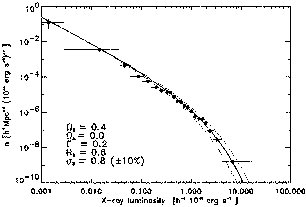
|
|
Abb. II-52: Fehlerellipse der kosmologischen
Parameter Omega und Amplitude der Dichtefluktuationen (sigma) aus der
beobachteten Temperaturfunktion röntgenstrahlender Galaxienhaufen.
Fig. II-52: Constraints on the
cosmological parameters Omega and amplitude of density fluctuations
(sigma) from the observed temperature function of X-ray galaxy clusters.
|
Abb. II-53: Röntgen-Leuchtkraftfunktion der
Galaxienhaufen aus der REFLEX-Stichprobe. Zudem werden Vorhersagen
kosmologischer Modelle mit den angegebenen Parametern gezeigt, die am besten
die Daten beschreiben.
Fig. II-53: X-ray luminosity
function for the cluster population of the REFLEX Survey. Also shown is the
prediction of the cosmological model (with parameters indicated in the
figure) which best describes the observations.
|
|
Zur Untersuchung der physikalischen Effekte, die letztendlich
zur Bildung von Galaxienhaufen führen, wie sie durch die Biasing-Modelle in
Abhängigkeit von der Haufenmasse beschrieben werden können, werden allerdings
noch umfangreichere Stichproben benötigt. Glücklichterweise ist die Ableitung
der Biasing-Funktion für Galaxienhaufen aufgrund der vergleichsweise einfachen
relevanten physikalischen Prozesse direkt aus den Beobachtungen möglich.
|
However, even larger cluster samples are
needed to study the physical effects that lead ultimately to the formation of
galaxy clusters, namely the biasing parameter as a function of cluster mass.
Thanks to the comparatively simple physical processes involved, it is
possible to deduce this biasing for galaxy clusters directly from
observations.
|
|
Deshalb werden derzeit unsere Haufenstichproben zu der
deutlich tieferen Flussgrenze von Fx=1.8x10-12 erg
s-1
cm-2 (ROSAT-Energieband 0.1-2.4 keV) für NORAS-II und
REFLEX-II, und zu geringeren galaktischen Breiten (Galactic Plane Survey)
erweitert. Dies eröffnet die Möglichkeit, die großräumige Verteilung der
Galaxienhaufen bis hin zu Gigaparsec-Skalen zu untersuchen und somit eines
direkten Vergleichs auf Skalen, bei denen Fluktuationen der kosmischen
Mikrowellen-Hinter-grundstrahlung von COBE gemessen wurden. Messungen auf
großen Skalen erfordern allerdings eine so genaue Kenntnis der Auswahleffekte,
dass artifizielle Fluktuationen unterhalb von 1%, wie sie beispielsweise
durch eine Unvollständigkeit der Stichprobe erzeugt werden, durch sorgfältige
Kontrolle der Auswahleffekte ausgeschlossen werden müssen. Unser derzeitiger
Durchmusterungsprozess folgt strengen Kriterien (viele Prozesse werden
vollautomatisch durchgeführt), wird durch umfangreiche N-Körpersimulationen
kontrolliert und erlaubt damit eine genügend genaue Modellierung der
Auswahleffekte.
|
Therefore, our cluster samples are
presently extended to a significantly deeper flux limit, Fx
=1.8x10-12 erg s-1 cm-2 for NORAS-II,
REFLEX-II in the ROSAT energy band 0.1-2.4 keV), and to lower galactic
latitudes (Galactic Plane Survey), which offers the possibility to study the
clustering properties of X-ray clusters up to Gigaparsec scales and thus to
provide a direct relation to the scale on which the structure in the
microwave background has been measured by COBE. Measurements on such large
scales need a clear documentation of the sample selection in order to avoid
artificial fluctuations due to, e.g., sample incompleteness below the 1
percent level. Our present cluster selection process follows strict rules
(many processes are accomplished purely automatically), is checked by
detailed N-body simulations, and allows a sufficiently detailed modelling of
the survey selection process.
|
|
Zur Illustration gibt Abb. II-54 eine
Darstellung der räumlichen Verteilung derzeit vorliegender
NORAS-II-Galaxienhaufen. Das endgültige Ziel ist die Erstellung eines den
gesamten Himmel umfassenden Katalogs mit mehr als 1500 Röntgen-selektierten
Galaxienhaufen, der als Ausgangspunkt vieler, genauer und systematischer
Untersuchungen der Radio-, Infrarot-, optischen und Röntgen-Eigenschaften von
Galaxienhaufen dienen wird.
|
An illustration of the spatial distribution
of the present NORAS-II clusters is given in Fig. II-54. The final
goal is the compilation of an all-sky catalogue comprising more than 1500
X-ray selected galaxy clusters, which also provides the starting point for
many detailed and systematic studies of the radio, infrared, optical, and
X-ray properties of clusters of galaxies.
|
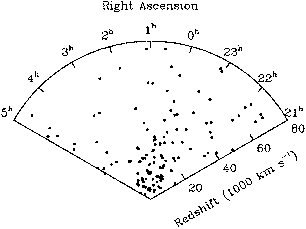
|
Abb. II-54: Keildiagramm einer Unterstichprobe
der NORAS-II-Durchmusterung. Dieser südliche Teil der galaktischen Kappe
umfasst ungefähr ein Drittel der gesamten NORAS-Himmelsfläche. Die räumliche
Verteilung der Haufen zeigt deutlich Strukturen auf Skalen von 200 Mpc. (Die
gesamte Tiefe des Diagramms entspricht etwa 1200 Mpc/h).
Fig. II-54: Wedge diagram of a
sub sample of the NORAS-II survey. The southern-galactic cap comprises about
one third of the total NORAS sky area. The spatial distribution of clusters
clearly reveals structures at scales of up to 200 Mpc. (The total depth of
the diagram corresponds to about 1200 Mpc/h).
|
| |
Böhringer, Komossa, Reiprich, Retzlaff, Schuecker, Trümper, Voges
|
|
4.3 Galaxienpopulationen in Haufen, Haufenverschmelzungen
und Radiohalos
|
4.3 Galaxy Population in Clusters, Mergers, and Radio Halos
|
|
Galaxienhaufen eröffnen die Möglichkeit der Untersuchung
der Populationen einer großen Anzahl von Galaxien bei derselben kosmischen
Epoche in Abhängigkeit ihrer unmittelbaren Umgebung. Es ist allgemein
bekannt, dass sich die Galaxienpopulationen von Haufen und Feld
unterscheiden, und auch als Funktion der Galaxienraumdichte in den Haufen
selbst. Mit einer Stichprobe der massereichsten Galaxienhaufen der
ROSAT-Durchmusterung mit gutbestimmten Haufeneigenschaften wird der
Galaxieninhalt großflächig durch optische Photometrie untersucht.
|
Galaxy clusters provide the possibility to
study the population of a large number of galaxies at the same cosmic epoch
as a function of the environment. It is well known that the galaxy population
is different in clusters and the field and varies also with the galaxy
density in the clusters. Having a sample of the most massive galaxy clusters
identified from the ROSAT Survey and well determined cluster properties at
hand, we are studying the galaxy content of these clusters by optical
large-area photometry.
|
|
Um das gesamte Haufengebiet zu überdecken, benutzen wir bei
unseren Messungen eine neue Generation großflächiger CCD-Mosaik-Kamera.
Instrumente des European Southern Observatory wie der Wide Field Imager (WFI)
am MPIA/ESO-2.2m-Teleskop und der Visible Multi Objekt Spectrograph (VIMOS)
an der dritten Einheit des Very Large Telescopes (VLT) sind unter den ersten
bereits bzw. bald verfügbaren Detektoren dieser Art. Unsere Untersuchungen
konzentrieren sich zunächst auf zwei vollständige Unterstichproben der
REFLEX-Durchmusterung bei Rotverschiebungen von etwa 0.15 und 0.3
(Abb. II-55). Die Hauptziele des Projektes sind (1) Untersuchungen
der morphologischen Eigenschaften und Sternbildungsaktivitäten individueller
Galaxien, die das optische Erscheinungsbild der Haufen bestimmen, und des
Einflusses der lokalen Umgebung auf ihre Eigenschaften, (2) Untersuchung der
Abhängigkeit der Galaxienleuchtkraftfunktion von der Struktur und den
gemessenen
Röntgeneigenschaften der Haufen, (3) die Verbesserung der Nutzung von
Galaxienhaufeneigenschaften als Distanzmaße und
Pekuliargeschwindigkeits-Indikatoren.
|
In this research we are exploiting a new
generation of wide-field mosaic imaging arrays to observe the full extent of
galaxy clusters. Instruments such as the European Southern Observatory's Wide
Field Imager (WFI) at the MPIA/ESO 2.2 m telescope and the forthcoming
Visible Multi-Object Spectrograph (VIMOS) coupled to the third telescope of
the Very Large Telescope (VLT) are among the first such detectors to become
available. The current studies are focused on two complete samples extracted
from the REFLEX Survey at redshifts of around 0.15 and 0.3 (Fig. II-55).
The main objectives of the project are (1) the studies of the morphological
type and star formation activity of the individual galaxies that dominate the
optical appearance of clusters, and how their characteristics are moderated
by their location in the host environments, (2) the study of the dependence
of the galaxy luminosity function on the structure and the measured X-ray
properties, (3) a refinement of the use of galaxy cluster properties as
distance and peculiar velocity indicators.
|
|
Für eine Stichprobe der 14 Röntgenleuchtkräftigsten und
massereichsten Galaxienhaufen mit Rotverschiebungen um 0.3 wurden ergänzende
Röntgenbeobachtungen für unser Vorhaben bewilligt. In Verbindung mit den
optischen
Beobachtungen wird es damit möglich, die dynamische Struktur der Haufen, das
Masse/Leuchtkraft-Verhältnis, das Verhältnis der Masse in schwereren Elementen
(z.B. Fe und Si) zum gesamten Sternenlicht und die Beziehung der Mischung der
Galaxienpopulationen als Funktion der Dichte des intergalaktischen Plasmas
erstmals mit hoher Genauigkeit zu bestimmen. Die Ergebnisse lassen
interessante Implikationen auf den Einfluss der Umgebung auf die
Galaxienentwicklung
wie auch auf die Geschichte der Produktion der schweren Elemente und der
integrierten Supernova-Rate der Sternpopulationen in Haufengalaxien
erwarten.
|
For the sample of the 14 most X-ray luminous and most massive galaxy clusters
at a redshift around 0.3 complementary
X-ray observations have been allocated for our program. In combination with
the optical observations we will be able to determine the dynamic structure
of the cluster, its mass to light ratio, the ratio of the mass of heavy
elements (e.g. Fe and Si) to the total stellar light, and the connection of
the galaxy population mix as a function of the intergalactic plasma density
for the first time with high precision. These results will make very
interesting implications possible on the influence of the environment on the
galaxy evolution as well as on the history of the heavy element production
and integrated supernova rate of the stellar populations in the cluster
galaxies.
|
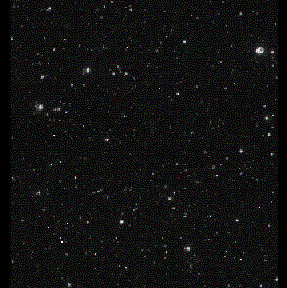
|
Abb. II-55: MPIA/ESO Wide Field Imaging
Camera-Beobachtung eines REFLEX-Galaxienhaufens mit der Rotverschiebung von
0.17. Der Himmelsausschnitt überdeckt ~6 Mpc bei der Rotverschiebung des
Galaxienhaufens.
Fig. II-55: MPIA/ESO Wide Field
Imaging Camera observation of one of the REFLEX Survey clusters at a redshift
of 0.17. The sky area is covering an extent of ~6 Mpc at the redshift of
the cluster.
|
|
Merger und Radiohalos
|
Mergers and Radio Halos
|
|
Gegenwärtig populäre Szenarien kosmischer Strukturbildung
gehen von einem hierarchischen Wachstum kosmischer Objekte aus, bei dem das
Merging (Verschmelzen) von Unterstrukturen von grundlegender Bedeutung ist.
Deshalb ist die Häufigkeit von Galaxienhaufen, die Unterstrukturen zeigen,
eine wichtige statistische Größe mit einer direkten Beziehung zur Kosmologie.
Anzeichen für merger-induzierte Stoßwellen können als starke Verzerrungen der
räumlichen und Temperaturverteilung der thermischen Bremsstrahlungsemission
des Innerhaufengases gemessen werden. Im Rahmen einer systematischen
Untersuchung der Unterstruktur der Röntgenstrahlung von den Galaxienhaufen,
die im ROSAT All Sky Survey gefunden wurden, konnten etwa 1000 Galaxienhaufen
(zusammengestellt aus drei sich teilweise überlappenden Haufenkatalogen)
analysiert werden. Nach Korrektur der Unterstruktur aufgrund zufälliger
Überlagerungen durch Vorder- und Hintergrundsquellen zeigen 35 ± 6 % der
Haufen signifikante Unterstrukturen. Schätzungen, basierend auf dem
erweiterten Press-Schechter-Konzept, ergeben gute Übereinstimmungen mit Cold
Dark Matter-Modellen mit einem hohen Wert der kosmologischen Konstanten,
wohingegen haufennormierte Standard Cold Dark Matter-Modelle die beobachteten
Raten um einen Faktor zwei überschätzen. Ein weiteres wichtiges Ergebnis ist
die Entdeckung einer Morphologie-Dichtebeziehung für Galaxienhaufen in dem
Sinne, dass Galaxienhaufen mit asymmetrischen, elongierten oder multimodalen
Flächenhelligkeitsverteilungen bevorzugt in Regionen erhöhter
Haufenanzahldichte auftreten.
|
Recent structure formation scenarios
suggest a hierarchical growth of cosmic objects where merging of sub-clumps
is a fundamental process. The frequency of galaxy clusters with subclumps
(substructures) is thus an important statistical quantity with a direct
relation to cosmology. The imprints of merger-induced shocks can be measured
as strong distortions of the spatial (and temperature) distributions of the
thermal bremsstrahlung emissivity of the intracluster gas. In a systematic
study of X-ray substructures in galaxy clusters detected in the ROSAT All-Sky
Survey we have analysed about 1000 clusters of galaxies (compiled from three
different
partially overlapping cluster catalogues). After correction for substructure
caused by chance superposition of foreground and background sources, 35 ± 6 %
of the clusters show significant substructure. Estimates
based on the extended Press-Schechter prescription are found to be consistent
with Cold Dark Matter models with a high value of the cosmological constant,
whereas cluster-normalized Standard Cold Dark Matter models over predict the
observed rate by more than a factor two. Another important result is the
discovery of a morphology-density relation for galaxy clusters, in the sense
that clusters with asymmetric, elongated, or multi-modal X-ray surface
brightness distributions are located preferentially in regions with higher
cluster number densities.
|
|
Die Unterstruktur-Analysmethoden werden auch zum Vergleich
der Röntgen-Morphologie von Galaxienhaufen mit Radiohalos, -relikten und
Cooling Flows benutzt. Radiohalos und -relikte wurden 1970 als diffuse, den
Haufen teilweise überdeckende und mit dem Intrahaufenplasma assoziierte
Synchrotronemissionen mit steilem Energiespektrum entdeckt. Diese
Radiosignaturen konnten bisher in nur etwa 30 vergleichsweise reichen und
kompakten Galaxienhaufen hoher Röntgenleuchtkraft und -temperatur entdeckt
werden. Der systematische Vergleich der Röntgenmorphologie der verschiedenen
Haufentypen mit einer Referenzstichprobe deutet an, dass im Gegensatz zu den
Cooling Flow-Haufen, die Halo- und Relikthaufen häufiger Substruktierungen
zeigen, und unterstützt damit die Vorstellung, dass durch Merger-Ereignisse
die Entstehung von Radiohalos und -relikten gefördert und existierende
Cooling Flows zerstört werden können.
|
The substructure analysis techniques are
also used to compare the X-ray morphology of radio halo/relic, and cooling
flow clusters. Radio halos and relics were discovered in 1970 as diffuse,
cluster-wide, steep spectrum synchrotron emission associated with the
intracluster plasma medium. This radio signature is found in only about 30
clusters of galaxies, preferentially in rich compact clusters with high X-ray
luminosity and temperature. The systematic comparison of the X-ray morphology
of the different cluster types reveals that, whereas cooling flow clusters
tend to show less frequent substructures, the halo and relic clusters show
more often substructures compared to the reference sample. This further
supports the idea that radio halos and relics are triggered by merger events,
while pre-existing cooling flows might be disrupted.
Böhringer, Lynam, Retzlaff, Schuecker, Trümper, Voges
|
|
4.4 Galaxien im frühen Universum
|
4.4 Galaxies in the early Universe
|
|
Zu verstehen, wie sich Sterne in Galaxien bilden, und wie
Galaxien selbst sich zu ihren vielfältigen heutigen Erscheinungsformen
entwickeln, ist von grundlegender Bedeutung für die Kosmologie. Durch die
heutigen Großteleskope (8-10m) sind wir in der Lage, in das Universum
"zurückzuschauen" und Galaxien zu beobachten, die entstanden als das
Universum noch jung war. Da die stärkste Sternentstehung in staubverhüllten
Wolken stattfindet, zeigen sich ihre Spuren hauptsächlich im infraroten Teil
des Spektrums. Deshalb sind Infrarotbeobachtungen entscheidend, um
herauszufinden wie sich die heftigsten Sternentstehungsereignisse ereignen,
und wie sich große Strukturen bilden, die wir heute sehen, zum Beispiel
elliptische und Spiralgalaxien und die Bulges von Galaxien.
|
Understanding
how stars within galaxies evolve and how galaxies themselves evolve into the
various morphological structures we see today is of fundamental importance to
cosmology. With the advent of big (8-10m) telescopes, we are now in a
position to "look back" into the Universe observing galaxies that were
created when the Universe was still young. Since the most massive
star-formation events take place in dust-enshrouded clouds the imprints of
their activity shows mostly in the infrared part of the spectrum. Thus,
infrared observations are crucial for finding out how the most violent star
formation episodes in the Universe occur and how the large structures we are
seeing today (ellipticals, S0-galaxies and bulges of spirals) were formed.
|
|
Mit dem ISAAC-Spektrograph an einem der ESO-VLT haben wir
ein Projekt begonnen, das darauf abzielt, die Kinematik und die dynamische
Entwicklung von Galaxien in einer wichtigen Phase des Universums zu verstehen.
Die Objekte für Untersuchungen der Dynamik haben wir aus unserem
erfolgreichen Projekt ausgewählt, das die Eigenschaften von Galaxien bestimmt
hat, die mit dem Infrared Space Observatory ISO im südlichen Hubble Deep
Field (HDF-S) entdeckt wurden. Das neue Projekt hat zu der außergewöhnlichen
Entdeckung der vermutlich massereichsten bekannten Spiralgalaxie geführt
(Abb. II-56 und II-57).
|
Using the ISAAC spectrograph on the ESO-VLT we have started a program aiming
at understanding
the kinematics and dynamical evolution of galaxies during a significant era
of the universe. We have selected the targets for dynamical studies from the
results of our successful program characterising the nature of a population
of galaxies discovered with the Infrared Space Observatory ISO in the Hubble
Deep Field South (HDF-S). The new project has led to the extraordinary
discovery of perhaps the most massive spiral galaxy known to date
(Fig. II-56 and II-57).
|
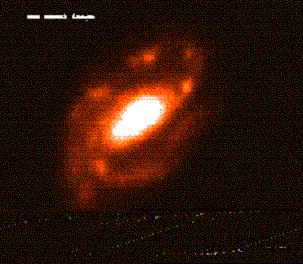
|
Abb. II-56:
HST-Aufnahme der Galaxie ISOHDFS 27
Fig. II-56:
HST image of the galaxy ISOHDFS 27
|
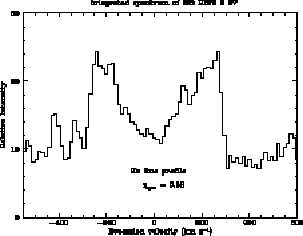
|
Abb. II-57:
Profil der H-alpha-Emissionslinie in ISOHDFS 27, mit dem typischen
Doppelmaximum einer rotierenden Scheibe. Aus dem Linienprofil leiten wir eine
Rotationsgeschwindigkeit von 420 km/s ab.
Fig. II-57:
Profile of the H-alpha emission line in ISOHDFS 27, showing the double horn
indicative of a rotating disk. The line profile implies a rotational Velocity
of 420 km/s.
|
|
Schon unsere niedrig aufgelöste Infrarotspektroskopie aus
dem letzten Jahr zeigte in dieser Galaxie, ISOHDFS 27 bei einer
Rotverschiebung von etwa 0.6, starke H-alpha-Emission aus einem Ausbruch von
Sternentstehung. Dieses Jahr haben wir hochaufgelöste (R~5000) Spektren
gewonnen, die die H-alpha-Emission auch räumlich auflösen. Damit können wir
erstmals die Dynamik solcher Galaxien untersuchen. Die Umlaufgeschwindigkeit
nach Korrektur für Projektionseffekte ist 420km/s, höher als in den meisten
bekannten Spiralen des lokalen Universums (Abb. II-57). Wir
bestimmen die enorme Masse von 1012 Sonnenmassen innerhalb eines
Radius von 18 kpc. Dies macht ISOHDFS 27 zur vermutlich massereichsten
bekannten
Spiralgalaxie und bedeutet, dass massereiche Strukturen schon vor mehr als 6
Milliarden Jahren existierten.
|
In this galaxy, ISOHDFS 27 at a redshift of about 0.6, our low resolution
infrared spectroscopy of last year detected strong H-alpha emission
originating in a burst of star formation. This year we obtained high
resolution optical (R~5000) spectra that also spatially resolve the H-alpha
emission. We can, thus, for the first time, probe the dynamical state of this
galaxy. The double horn shape of the line profile (Fig. II-57)
implies the presence of a rotating disk. The rotational velocity corrected
for projection and beaming effects is 420 km/s, higher than for almost all
known spirals in the local Universe. We determine an enormous mass of
1012
solar masses enclosed within 18 kpc. This makes ISOHDFS 27 perhaps the most
massive spiral galaxy known to date, implying that massive structures were
already in place 6 billion years ago.
|
|
Wir haben vor, die Untersuchungen von Quellen bei hoher
Rotverschiebung mit starker Emission im mittleren Infrarot auszuweiten. In
Zusammenarbeit mit dem amerikanischen SIRTF-IRAC-Team untersuchen wir im
Sichtbaren
und nahen Infrarot ein großes Gebiet um das südliche Chandra-Feld, um im
Optischen
oder Nahinfraroten die Natur der Quellen zu identifizieren, die in tiefen
Durchmusterungen mit SIRTF im mittleren Infrarot gefunden werden.
|
We are planning to extend these studies of high-redshift sources with strong
mid-IR emission. In collaboration with the US SIRTF-IRAC team we are imaging
in the near infrared and visible a wide area located in the Chandra-South
field. We aim at providing the near-IR/optical counterparts of the sources
discovered through deep mid-infrared surveys carried out with
SIRTF.
|
|
Um eine merkliche Zahl der hellsten
(Sub)mm-Hintergrundsquellen zu finden, führen wir in einer Zusammenarbeit
von Max-Planck-Institut für
Radioastronomie (MPIfR), MPE und dem National Radio Astronomy Observatory
NRAO
eine tiefe (~0.5mJy) Durchmusterung großer Felder (jeweils mehr als 100
Quadratbogenminuten) bei einer Wellenlänge von 1.2mm durch. Wir benutzen das
Max-Planck Millimeter Bolometer Array MAMBO am IRAM 30m-Teleskop auf Pico
Veleta,
Spanien. Die gefunden Quellen tragen signifikant zum kosmischen
(Sub)mm-Hintergrund bei und sind vermutlich staubreiche Objekte bei hoher
Rotverschiebung mit Sternentstehungsraten bis zu einigen Tausend Sonnenmassen
im Jahr.
|
To detect a significant number of the brightest (sub)mm background sources, a
collaboration of scientists from Max-Planck-Institut für Radioastronomie
(MPIfR), MPE and the National Radio Astronomy Observatory (NRAO) is conducting
a deep (~0.5mJy), wide (each field more than 100 square arcmin) survey at a
wavelength of 1.2mm. We are using the MPIfR Millimetre Bolometer Array -
MAMBO - at the IRAM 30m millimetre telescope on Pico Veleta, Spain. The
detected sources contribute significantly to the cosmic (sub)mm background
and are likely to be dusty high-redshift objects with star formation rates of
up to several thousand solar masses per year.
|
|
Da die Antennenkeule des 30m-Telekops mit 11" zu groß für
eine klare Quellenidentifizierung allein aus den mm-Daten ist, führen wir
Radio/mm-Interferometrie und optische und Nahinfrarot-Folgebeobachtungen
durch, um die Quellen in zwei Feldern zu identifizieren. Identifikationen und
schließlich Rotverschiebungen sind nötig, um die Beziehung von
(Sub)mm-Galaxien zu anderen Objektklassen bei hoher Rotverschiebung zu
bestimmen, wie etwa Lyman-Break-Galaxien, QSOs, oder extrem rote Objekte. (Da
Galaxien bei Wellenlängen kurzwelliger als die Ionisationskante von
Wasserstoff, Lyman Kante, kaum Licht ausstrahlen, sind hochrotverschobene
Galaxien nicht mehr im Optischen sondern nur im Infraroten zu beobachten. Man
nennt diese Objekte Lyman-Break-Galaxien.) Sie werden ebenfalls dringend
nötige Hilfe bei der Beantwortung der Frage leisten, was der Beitrag aktiver
Galaxienkerne zum kosmischen Ferninfrarothintergrund ist.
|
Since the 11" beam of the 30m telescope is too large to allow for proper
source identification using the mm data alone, we are carrying out follow-up
radio/mm interferometry and optical/IR observations to identify the mm
sources detected in two fields. Identifications and ultimately redshifts are
needed to understand the relation of (sub)mm galaxies to other classes of
high redshift objects, like Lyman break galaxies, QSOs, or the so-called
extremely red objects. (Since galaxies hardly emit any radiation shortward of
the ionisation edge of hydrogen, the Lyman break, highly redshifted galaxies
are no longer visible in the optical but in the infrared. These objects are
termed Lyman-break-galaxies.) They will also shed much needed light on the
question as to the fractional contribution of active galactic nuclei to the
cosmic far-infrared background.
|
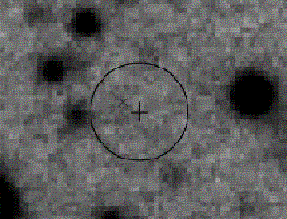
|
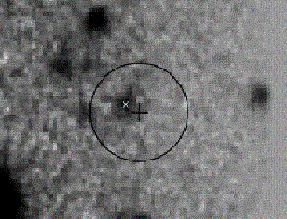
|
|
Abb. II-58: Tiefe R-Band- (links) und
K-Band-Aufnahme (rechts) an der Position der MAMBO 1.2mm-Quelle Abell2125-10.
Das schwarze Pluszeichen zeigt die Position der Mambo-Quelle und der Kreis
mit einem Durchmesser von 10.7" die Teleskopkeule. Die 20cm-Radioquelle ist
als kleines Kreuz angedeutet. Die MAMBO-Quelle wird mit einem roten
(R-K>5) asymmetrischen Objekt an der Position der Radioquelle
identifiziert
Fig. II-58:
Deep R-band (left) and K-band (right) images at the location of the MAMBO
1.2mm source Abell2125-10. The black plus symbol indicates the position of
the MAMBO source and the circle with a diameter of 10.7" represents the
telescope beam. The 20cm radio source (~100μJy) is shown as a small
cross. The MAMBO source is identified with a red (R-K>5) asymmetric object
coincident with the radio source.
|
|
In einem unserer Felder, zentriert auf den Galaxienhaufen
Abell 2125, haben wir mehr als 30 MAMBO-Quellen entdeckt. Wir identifizieren
mögliche Gegenstücke aus einer empfindlichen VLA-Karte, und aus tiefen
R-Band- (~25.3 mag) und K-Band-Aufnahmen (~21.5 mag) vom 2.2m und
3.6m-Teleskop auf Calar Alto. Mehr als die Hälfte der starken MAMBO-Quellen
haben VLA-Gegenstücke während nur 0.2 Zufallskoinzidenzen für das ganze Feld
erwartet werden. Abschätzungen der Rotverschiebung aus dem Spektralindex
zwischen Radio- und mm-Bereich legen nahe, dass diese Objekte bei hoher
Rotverschiebung mit einem Median von 2.5 liegen. Die genauen
interferometrischen Positionen erlauben die Identifikation von Gegenstücken
die ziemlich blaue, ebenso wie extrem rote (R-K>5) Objekte einschließen,
sowie Felder ohne optische oder nahinfrarote Gegenstücke
(Abb. II-58).
|
In one of our fields, centred on the cluster of galaxies Abell 2125, we
have detected more than 30 MAMBO sources. We identify possible counterparts
from a sensitive VLA map, and from deep R-band (~25.3mag) and K-band
(~21.5mag) observations carried out at the 2.2 and 3.6m telescopes at Calar
Alto. More than half of the strong MAMBO sources do show VLA counterparts,
while we would expect only 0.2 chance coincidences for the entire field.
Coarse redshift estimates based on the radio-mm spectral index suggest that
these objects lie at high redshifts with a median redshift of 2.5. The
accurate
interferometric positions allow the identification of counterparts which
include relatively blue as well as extremely red (R-K>5) objects, and
fields which are blank at the depth of our optical and near-infrared data
(Fig. II-58).
|
|
Das zweite Feld ist zentriert auf das NTT Deep Field, das
wegen der Verfügbarkeit sehr tiefer optischer und Nahinfrarotaufnahmen und
Erreichbarkeit von IRAM und VLT ausgewählt wurde. Mit mehr als 40 Quellen ist
das MAMBO-Bild dieses Feldes das reichhaltigste Bild das jemals bei mm oder
submm-Wellenlängen aufgenommen wurde. Tiefe optische Aufnahmen eines großen
Felds wurde aufgenommen um die öffentlichen Daten des NTT Deep Field zum
größeren MAMBO-Feld zu ergänzen.
|
The second field is centred on the ESO NTT Deep Field, selected because of the
availability of very deep optical/near-infrared multicolour imaging and
accessibility from IRAM and the VLA. With more than 40 sources, the MAMBO
image of this field is the richest blank field image ever taken at mm or
sub-mm wavelengths. Deep, wide-field optical imaging has been taken to extend
the public ESO NTT Deep Field data to the larger size of the MAMBO
field.
|
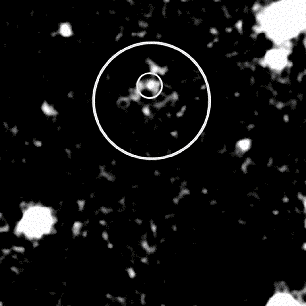
|
Abb. II-59: Eine tiefe K-Band-Aufnahme identifiziert
die SCUBA-Quelle Lockman 850.1 mit dem hellsten Maximum in einem komplexen,
geklumpten Objekt das möglicherweise eine sich gerade bildende elliptische
Galaxie darstellt. Die genaue interferometrische IRAM-Position ist durch den
kleinen Kreis angedeutet.
Fig. II-59:
Deep K band image identifying the SCUBA source Lockman 850.1 with the
brightest peak in a complex, clumpy object possibly representing an elliptical
galaxy in formation. The accurate IRAM interferometric position is indicated
by the small circle.
|
|
Unser Projekt zur Identifikation von SCUBA-Submm-Quellen
ist in Zusammenarbeit mit dem britischen Submm-Konsortium fortgesetzt worden.
Trotz der tragischen Unfälle am Plateau de Bure-Interferometer konnte IRAM
uns eine genaue interferometrische Lokalisierung der hellsten Submm-Quelle
liefern, die im vom britischen Konsortium durchmusterten Teil des Lockman
Hole gefunden wurde. Eine tiefe K-Band-Aufnahme (Abb. II-59)
identifiziert die Submm-Quelle mit einem geklumpten, ausgedehnten Objekt.
Diese Morphologie, ähnlich der von Radiogalaxien bei hoher Rotverschiebung,
und die enorme abgeleitete Sternentstehungsrate legen nahe, dass wir Zeuge
der Entstehung einer massereichen elliptischen Galaxie sind.
|
Our program of identification of SCUBA submm sources has also continued in
collaboration with the UK submm survey consortium. Despite the tragic
accidents at the Plateau de Bure interferometer, IRAM was able to provide us
with an accurate interferometric location of the brightest submm source in
the region of the Lockman Hole that has been surveyed by the UK consortium. A
deep K band image (Fig. II-59) identifies the submm source with a
clumpy, extended object. This morphology, reminiscent of high redshift radio
galaxies together with the huge inferred star formation rate suggest that we
may be witnessing the formation of a massive elliptical
galaxy.
|
|
Galaxien bei hoher Rotverschiebung mit Sternentstehung
können durch auf den Lyman-Break (Ultraviolett im Ruhesystem) abgestimmte
optische Aufnahmen gefunden werden, oder durch Millimeter-Aufnahmen, die die
Staubemission (Ferninfrarot im Ruhesystem) messen. Bis heute haben die mit
beiden Methoden gefundenen Galaxien zwei fast völlig getrennte Stichproben
gebildet. Verständnis der Sternenstehungsgeschichte des Universums und der
Galaxienentwicklung erfordert jedoch Verständnis der UV- und
Ferninfraroteigenschaften beider Klassen. Wir müssen also die
UV-Emission ferninfrarotselektierter Objekte und die Ferninfrarotemission
UV-selektierter Objekte untersuchen. Der zweite Ansatz ist besonders
wertvoll, denn er erlaubt Bestimmung des Anteils am kosmischen
Ferninfrarothintergrund, der von optisch detektierbaren
"Lyman-Break-Galaxien" herrührt, statt von staubumhüllten Starbursts oder
aktiven Kernen.
|
Star-forming galaxies at high redshift can be identified by optical imaging
tuned to their
(rest frame ultraviolet) Lyman break, or by millimetre imaging that detects
their (rest far-infrared) dust emission. Until now, the galaxies detected by
these techniques have defined two samples that are almost entirely disjoint.
However, an understanding of the universe's history of star formation (and
therefore, galaxy evolution) requires that we understand the UV and far-IR
properties of both classes. We must therefore study the rest UV
emission from far-IR-selected objects and the rest far-IR emission from
UV-selected objects. The latter approach is especially valuable, since it
allows us to constrain what fraction of the cosmic far-IR background comes
from optically detectable "Lyman break" galaxies, rather than from
dust-enshrouded starbursts or active nuclei.
|
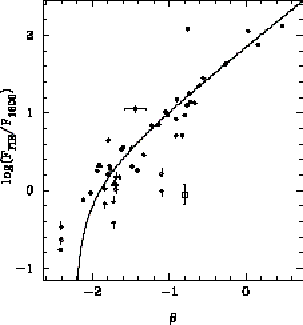
|
Abb. II-60: Die durch Gravitationslinsenwirkung
verstärkte Lyman-Break-Galaxie cB58 (Quadrat) folgt nicht der für nahe
Starburstgalaxien geltenden Beziehung zwischen dem Verhältnis aus Ultraviolett-
und Ferninfrarotemission und der Steigung β des Ultraviolettspektrums.
Fig. II-60:
The gravitationally lensed Lyman Break galaxy cB58 (square) does not follow
the relation between the ratio of ultraviolet and far-infrared emission, and
the UV spectral slope β that has been determined for local starburst
galaxies.
|
|
Wir haben mit MAMBO am IRAM-30m-Teleskop Staubemission der
hellsten bekannten Lyman-Break-Galaxie gemessen - der durch einen
Galaxienhaufen gravitationslinsenverstärkten Quelle cB58 bei einer
Rotversschiebung
von 2.7, und die Verstärkung von ~30 genutzt um, bis zu einem niedrigen
intrinsischen Niveau der Staubemission vorzudringen. Im Vergleich zu nahen
UV-hellen Starburstgalaxien, die mögliche Analoga der Lyman-Break-Galaxien
bei z~3 sind, scheint cB58 wesentlich weniger Ferninfrarotemission zu haben
als aus der Steigung des UV-Spektrums vorausgesagt wird. Während nahe
Starbursts eine starke Korrelation aufweisen zwischen (a) dem Anteil der
UV-Emission, der durch Staub im fernen Infrarot wieder abgestrahlt wird und
(b) der durch die Steigung β des UV-Spektrums gemessenen Rötung, liegt
cB58 ungefähr einen Faktor 15 unterhalb dieser Beziehung (Abb. II-60).
|
We have used the MAMBO array at the IRAM 30m telescope to detect dust emission
from the brightest known Lyman break galaxy -- the gravitationally lensed
source cB58 at a redshift of 2.7. We have exploited the lens magnification by
a foreground galaxy cluster of ~30 to probe to a very faint level of
intrinsic dust emission. In comparison to the local, UV-bright starburst
galaxies which are the putative analogues of the z~3 Lyman break galaxies,
cB58 appears to produce far less far-IR emission than the slope of its UV
spectrum predicts. Whereas nearby starbursts show a strong correlation
between (a) the fraction of UV emission which is reradiated by dust in the
far-infrared window, and (b) the reddening by dust measured by the UV
spectral slope β, cB58 falls a factor of ~15 below this relation
(Fig. II-60).
|
|
Dieses Ergebnis legt nahe, dass die Steigung des UV-Spektrums
von cB58 entweder ungenau oder nicht konsistent mit den lokalen Starbursts
gemessen wurde. Eine negativere (blauere) Steigung wäre in Übereinstimmung
mit dem unabhängig erschlossenen niedrigen Staubgehalt. Obgleich Unsicherheit
in der Staubtemperatur von cB58 uns an endgültigen Aussagen über die Lage von
cB58 im Vergleich zu der Beziehung für nahe Galaxien hindert, hat unsere
Hypothese einer ungenauen und/oder inkonsistenten Messung wichtige
Folgerungen für das Verständnis von Sternentstehung bei hoher Rotverschiebung.
Versuche, die UV-Emission von Lyman-Break-Galaxien für Extinktion zu
"korrigieren" und ihren Beitrage zum Ferninfrarot-Hintergrund zu
extrapolieren, hängen entscheiden von einer genauen Messung der Steigung des
UV-Spektrums ab. Wenn diese in anderen Lyman-Break-Galaxien so schlecht wie
in cB58 bestimmt ist, scheint klar, dass nur auf optischen Beobachtungen
beruhende
Behauptungen über diese Population mit großer Vorsicht zu behandeln sind.
|
This
result suggests that cB58's UV spectral slope has been measured either
inaccurately or inconsistently with respect to the local starburst sample. A
more negative (i.e., bluer) slope would agree with the low dust content
inferred independently. While uncertainty in the dust temperature in cB58
prevents
us from making a conclusive statement about whether this Lyman break galaxy
falls above, below, or exactly on the relation for local starburst galaxies,
our hypothesis of an inaccurate and/or inconsistent measurement of the UV
spectral slope has important consequences for our understanding of star
formation at high redshift. Attempts to "correct" the observed rest-UV
emission from Lyman break galaxies for extinction, and to extrapolate their
contribution to the far-IR background, depend crucially on proper measurement
of the UV spectral slope. If the UV spectral slope is as poorly constrained
in other Lyman break galaxies as it is in cB58, it seems clear that claims
which are based on only optical observations of this population should be
treated with great caution.
|
|
Zur Vorbereitung der Mission des FIRST Satelliten haben wir
ein neues Projekt begonnen mit dem Ziel, die beste Strategie für tiefe
Durchmusterungen des Himmels im fernen Infrarot mit dem PACS-Instrument des
MPE an Bord von FIRST zu bestimmen, und seinen wissenschaftlichen Ertrag im
Feld der Galaxienentstehung und -entwicklung zu optimieren. Die üblichen
Methoden Informationen aus Durchmusterungen zu gewinnen, wie z.B. Berechung
von Quellenzählungen und Korrelationsfunktionen, können nicht zu einer völlig
befriedigenden Bestimmung der Quelleneigenschaften führen. Die Schwierigkeit
der Identifikation und Rotverschiebungsmessung schwacher Infrarotquellen
fordert maximale Information aus der Durchmusterung selbst. Simulationen mit
Monte-Carlo-Verfahren sind nötig. Die Simulationen basieren auf dem Ansatz
der "Rückwärtsentwicklung". Sie sind in einem größeren infrarotastronomischen
Zusammenhang aufgesetzt und berücksichtigen für die Galaxienevolution
relevante Ergebnisse aus bereits durchgeführten Experimenten. Sie werden
außerdem eine unabhängige Interpretation der Ergebnisse anderer
Infrarot/Submillimeterexperimente ermöglichen.
|
In preparation for the launch of the FIRST satellite we started a project that
aims to define the best observing strategy for deep surveys of the
far-infrared sky with the MPE lead PACS and to optimise its scientific return
in the field of galaxy formation and evolution. The standard procedures to
extract information from a survey, e.g. computing the number counts and the
correlation functions, will not lead to a fully satisfactory determination of
the source characteristics. The difficulty of the identification and redshift
determination of faint infrared sources makes Monte Carlo Simulations
necessary to extract the maximum information from the surveys. The
simulations are based on a "backward evolution" approach. They are set up in
a wider infrared context and take into account the available constraints on
galaxy evolution from other experiments. They will also allow an independent
interpretation of the results from other far-infrared/submillimetre
experiments.
|
|
Wir haben tiefe NICMOS-Aufnahmen einer Stichprobe von fünf
radioleisen Quasaren bei hoher Rotverschiebung (2<z<3) und mit
niedriger absoluter Leuchtkraft des Kerns gewonnen, und vermutlich die
umgebenden Galaxien (‚Hosts’) für alle Quasare gefunden. Die meisten dieser
Galaxien haben Leuchtkräfte ähnlich den heutigen leuchtkräftigen
"L*"-Galaxien, mit einem Bereich von 0.2 L* bis etwa 4 L*. Diese Hostgalaxien
haben Helligkeiten und Größen wie Lyman-Break-Galaxien bei gleicher
Rotverschiebung
und Ruhewellenlänge, sind aber etwa zwei Magnituden schwächer als starke
Radiogalaxien und Hosts von radiolauten Quasaren. Die Hosts unserer
Stichprobe bei hoher Rotverschiebung sind ähnlich oder schwächer als die
Hosts radioleiser Quasare bei niedriger Rotverschiebung mit ähnlicher
absoluter Leuchtkraft des Kerns. Die Galaxien bei hoher Rotverschiebung haben
aber vermutlich nur 10-20% der stellaren Masse ihrer Gegenstücke bei niedriger
Rotverschiebung. Eine Anwendung der Beziehung für heutige Sphäroide zwischen
Bulgemasse und Masse des schwarzen Lochs würde nahe legen, dass sie schwarze
Löcher mit Massen um 100 Millionen Sonnemassen enthalten. Ein Vergleich mit
der Helligkeit ihrer Kerne ergibt Akkretionsraten nahe dem oder am
Eddington-Grenzwert. Obwohl diese Galaxien bei hoher Rotverschiebung bereits
superschwere schwarze Löcher enthalten, müssen sie noch merklich wachsen, um
sich zu heutigen L*-Galaxien zu entwickeln. Diese Ergebnisse sind
grundsätzlich verträglich mit theoretischen Vorstellungen über den
hierarchischen Aufbau der Muttergalaxie und ihre Beziehung zum zentralen
superschweren schwarzen Loch.
|
We
have made a deep NICMOS imaging study of a sample of five high redshift
(2<z<3) radio-quiet quasars with low absolute nuclear luminosities, and
have detected apparent host galaxies in all of these. Most of the hosts have
luminosities approximately equal to present-day fairly luminous "L*"
galaxies, with a range from 0.2 L* to about 4 L*. These host galaxies have
magnitudes and sizes consistent with those of the Lyman break galaxies at
similar redshifts and at similar rest wavelengths, but are about two
magnitudes fainter than high-z powerful radio galaxies and radio-loud quasar
hosts. The hosts of our high-z sample are comparable to or less luminous than
the hosts of the low-z radio quiet quasars with similar nuclear absolute
magnitudes. However, the high-z galaxies are more compact than the hosts of
the low-z quasars, and probably have only 10-20% of the stellar mass of their
low-z counterparts. Application of the relation between bulge mass and black
hole mass found for present-day spheroids to quasars would indicate that they
contain black holes with masses around 100 Million solar masses. Comparison
to their nuclear magnitudes implies accretion rates that are near or at the
Eddington limit. Although these high-z galaxies already contain super massive
black holes, they will need to grow significantly to evolve into present-day
L* galaxies. These results are basically consistent with theoretical
predictions
for the hierarchical build-up of the galaxy host and its relation to the
central super massive black hole.
|
| |
Andreani, Baker, Barden, Dannerbauer, Genzel, Lehnert, Lutz, Moy, Rigopoulou,
Tacconi, Thatte
|
|
4.5 Zum Ursprung der kosmischen Hintergrundstrahlung im Röntgen- und
Gammabereich
|
4.5 On the Origin of the Cosmic Background Radiation in the X- and
Gamma-Ray Range
|
|
Die Hintergrundstrahlung im Röntgen- und Gammabereich ist
von großem kosmologischen Interesse, weil sich in ihr die gesamte kosmische
Entwicklung widerspiegelt. Im Röntgenbereich konnte mit Hilfe der tiefen
Durchmusterungen
mit ROSAT bei einer Flussgrenze von 5x10-15 erg/cm2s im
0.5-2 keV Band etwa 70-80 % des Röntgenhintergrundes bei 1 keV in diskrete
Quellen aufgelöst werden. Eine nahezu vollständige Identifizierung der
detektierten Quellen hat gezeigt, dass es sich dabei im Wesentlichen um
aktive galaktische Kerne (AGN), also Seyfertgalaxien und Quasare handelt. Mit
der ultratiefen Durchmusterung von ROSAT wurde inzwischen eine Flussgrenze
von 1.2x10-15 erg/cm2 im 0.5-2 keV Band erreicht und
mit Hilfe von Keck-Spektren konnten 90% der insgesamt 94 Quellen identifiziert
werden. Die Mehrzahl der Quellen (57) sind AGN vom Typ I mit breiten
Emissionslinien,
während 13 AGN lediglich schmale Emissionslinien oder Balmer-Emissionslinien
mit einem großen Balmerdekrement (AGN Typ II) zeigen, die auf eine
signifikante
Absorption im Optischen hinweisen. Die zweithäufigste Klasse sind Gruppen
oder Haufen von Galaxien (~ 11%). Wir finden keine Änderungen der
Populationen zwischen der tiefen und ultratiefen Durchmusterung. Inzwischen
wurde der Vorstoß zu noch schwächeren Quellen mit Chandra und XMM fortgesetzt.
|
The background radiation in the X- and gamma-ray range is of great
cosmological interest because it reflects
the whole of cosmic evolution. With the help of the deep survey with ROSAT,
which achieved a flux limit of 5x10-15 erg/cm2s in the
0.5-2 keV band, it was possible to resolve about 70-80% of the X-ray
background up to 1 keV as discrete point sources. A nearly complete
identification
of the detected sources has shown that they are mainly active galactic nuclei
(AGN) like Seyfert galaxies and quasars. In the meantime the ultra-deep
survey of ROSAT has reached a flux limit of 1.2 x10-15
erg/cm2
in the 0.5-2 keV band and it has been possible to identify 90% of the 94
sources with the help of Keck-spectroscopy. The majority of these sources
(57) are AGN of type I with broad emission lines, while 13 AGN show only
narrow
emission lines or Balmer emission lines with a large Balmer decrement (AGN
type II), which indicates a significant absorption in the optical. The second
most numerous class are groups or clusters of galaxies (~11%). We find no
change of the populations between the deep and the ultra-deep survey.
Meanwhile even weaker sources are being searched for with Chandra and
XMM-Newton.
|
|
Für den Bereich der Gammastrahlung steht eine genaue
Quellidentifikation noch aus, aber alles deutet darauf hin, dass es sich
dabei auch um Beiträge von nicht-aufgelösten Punktquellen handelt. Im
Energiebereich bis etwa ~ 500 keV dominieren vermutlich AGN, während oberhalb
von etwa 5 MeV nach den EGRET-Ergebnissen der wesentliche Beitrag von
Gamma-Blasaren
herrührt. Im Energiebereich dazwischen vermutet man, dass der Gammahintergrund
von kosmologischen Supernovaexplosionen stammt, wobei der Zerfall der in der
Ex-plosion erzeugten radioaktiven Elemente zu ausreichend intensiver
Gammastrahlung im Bereich 500 keV - 5 MeV führt. Die Gammaspektren
dieser Supernovaexplosionen sollten bestimmte Signaturen (Kanten) aufweisen,
die sowohl die Quelltypidentifikation als auch die Bestimmung der
Rotverschiebungsverteilung
ermöglichen sollte (Abb. II-61).
|
In the gamma-ray range a precise source identification is still lacking, but
everything points to the fact that also in this case it involves
contributions from non-resolved point sources. In the energy range up to ~500
keV AGN very probably dominate, while above about 5 MeV, according to the
EGRET results, the main contribution comes from gamma blazars. In the
intermediate energy range it is possible that the gamma-ray background is due
to cosmological supernovae, in which the
decay of the radioactive elements created by the explosion leads to
sufficiently intense gamma-radiation
in the range 500 keV - 5 MeV. The gamma-ray
spectra of these supernova explosions should have characteristic signatures
(edges) which should allow the identification of the sources as well as the
determination of the redshift distribution (Fig. II-61).
|
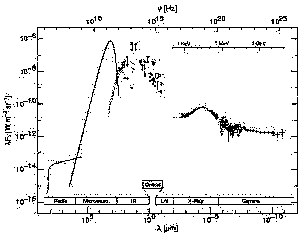
|
Abb. II-61: Das kosmisch-diffuse Hintergrundspektrum
vom Radio- bis zum Gammabereich. Die einzelnen Emissionskomponenten (der
extragalaktische Radiohintergrund, die 3 K Schwarzkörperstrahlung und
das extragalaktische Hintergrundlicht) oberhalb 0.1 µm sind deutlich
erkennbar.
Fig. II-61: The cosmic-diffuse background spectrum from the radio to
the gamma-ray range. The single emission components (the extragalactic
radio background, the 3 K black body radiation and the extragalactic
background light) above.
|
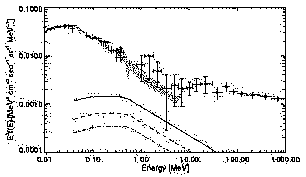
|
Abb. II-62: Das Spektrum der kosmisch-diffusen
Hintergrundstrahlung von 10 keV bis 1 GeV. Die drei eingezeichneten Kurven
geben die Abschätzungen des Beitrags von FR I Galaxien an. Die oberste Kurve
nimmt eine positive, die mittlere keine und die unterste eine negative
Evolution der Leuchtkraft an.
Fig. II-62: The spectrum of the
cosmic-diffuse background radiation from 10 keV to 1 GeV. The three lines at
the bottom show the contribution from FRI galaxies. The top curve assumes a
positive, the middle one no and the bottom one a negative evolution of the
luminosity.
|
|
Eine weitere Möglichkeit, den kosmischen Hintergrund im Energiebereich um 1
MeV zu erklären, ist durch einen Beitrag von aktiven Galaxien
(AGN). Die einzige bis heute in diesem Energiebereich nachgewiesene "normale"
aktive Galaxie ist Centaurus A (Cen-A, NGC 5128) mit einem Abstand von nur
ca. 3 Mpc. Da wir den Jet unter einem großen Winkel von ca. 70° sehen, ist
Cen-A als "normaler" radiolauter AGN zu betrachten. Unter dieser Annahme und
mit Hilfe der Gamma- zu Radioleuchtkräfteverhältnisse von 5 radiolauten
Seyfertgalaxien wurde der Beitrag dieser Objekte zur kosmischen
Hintergrundstrahlung im Gammabereich von 500 keV - 5 MeV abgeschätzt. Dabei
ergibt sich, dass unter den günstigsten Bedingungen (positive Evolution der
Leuchtkräfte) maximal 20 % des Flusses im MeV-Bereich durch die Summe aller
aktiven Galaxien mit nicht auf uns gerichteten Jets erklärt werden können
(Abb. II-62)
|
Another possibility to explain the cosmic
background in the energy range around 1 MeV is via the contribution of active
galaxies (AGN). Up to now the only detected "normal" active galaxy in this
energy range is Centaurus A (Cen-A, NGC 5128), which is only 3 Mpc away.
Since we see the jet under a large angle of about 70° Cen-A can be considered
as a "normal" radio loud AGN. With this assumption and with the help of the
gamma-to-radio-luminosity ratios of 5 radio loud Seyfert galaxies the
contribution of these objects to the cosmic background radiation in the
gamma-range from 500 keV - 5 MeV has been estimated. The result is that
under the most favourable conditions (i.e. positive evolution of the
luminosities) at most 20% of the flux in the MeV-range can be explained by
the sum of all active galaxies whose jets are directed towards us
(Fig. II-62).
Hasinger, Lichti, Schmidt, Steinle, Trümper, Weidenspointner
|















